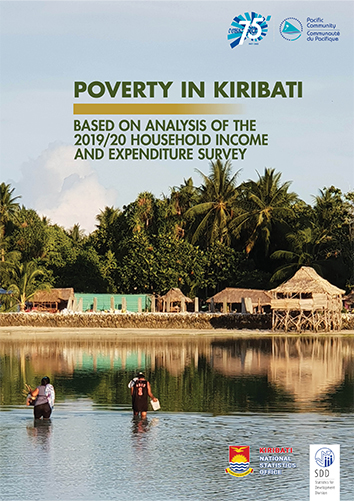Household Income and Expenditure Surveys (HIES) provide a wealth of information with both macro-and microeconomic applications, including rebasing the household component to GDP and the consumer price index, as well as providing insight into household production and consumption habits. Kiribati’s 2019/20 Household Income and Expenditure Survey – the second since its inaugural in 2006 – has resulted in numerous statistical outputs in the areas of household income and expenditure, food consumption, food security and labour markets (in press). The report titled ‘Poverty in Kiribati based on analysis of the 2019/20 household income and expenditure survey’ was published in July 2022 and is the most recent analytical product resulting from Kiribati’s 2019/20 HIES.
The analysis finds that 21.9% of I-Kiribati are living in poverty. Poverty rates vary by geographic location, education level and labour market characteristics of the household. The highest rates of poverty are in the Southern Division (32%) and Northern Division (26%); however as these regions have relatively low populations, they collectively only account for around 40% of Kiribati’s poor. Even though the poverty rate on the most populous island, South Tarawa, is relatively low (19%), the high overall population means that almost half of Kiribati’s poor live in the capital. Households whose head of household had higher levels of education have lower poverty rates: this relationship was much stronger in South Tarawa than elsewhere. Poverty rates were lowest among households whose heads were wage employees.
Two distinct groups of the poor exist in Kiribati, which presents a strategic challenge for the Government of Kiribati. The first group, in South Tarawa, have better access to services, higher levels of human capital, and greater opportunities for formal employment than poor household s elsewhere in Kiribati. Despite the apparent economic advantages of the residents of South Tarawa, they are still unable to meet their basic needs. The second group live in the Southern and Northern Divisions and are the most deprived in terms of both monetary and non-monetary measures. The lack of access to services in these Divisions means that even most non-poor households do not have access to reliable sources of electricity, safe drinking water, and basic sanitation. The different characteristics of these two groups of the poor means that a variety of policies are likely required to reduce poverty across Kiribati.
The Kiribati National Statistics Office, the World Bank and the Pacific Community are acknowledged for their important contribution to the Kiribati 2019/20 HIES and the production of the report ‘Poverty in Kiribati based on analysis of the 2019/20 household income and expenditure survey’.
Read the Kiribati Poverty report.
